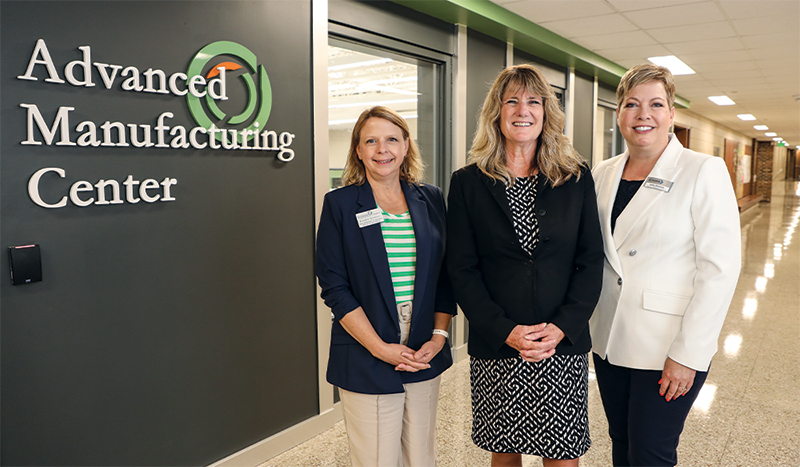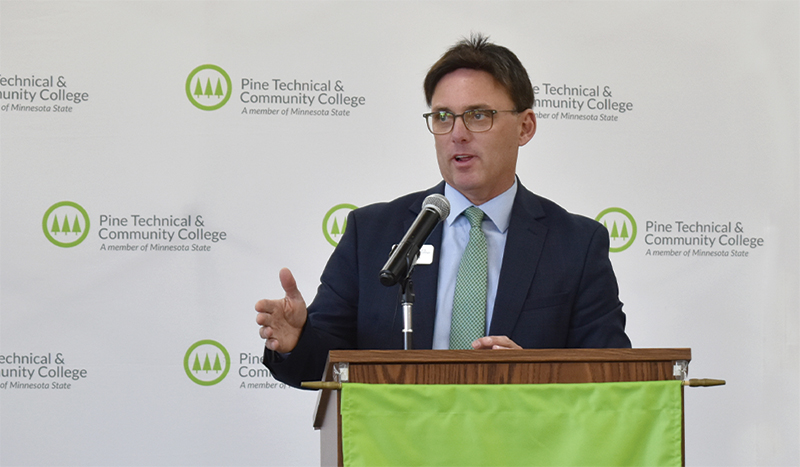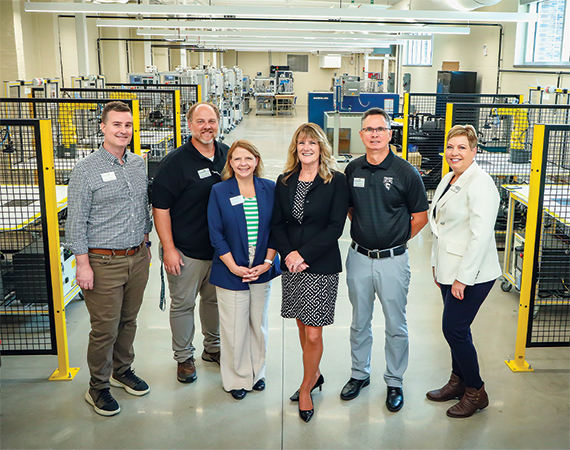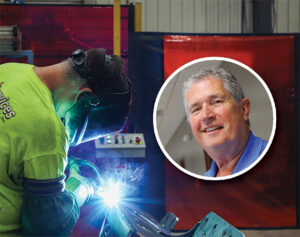As interest in trade and technical education surges among young people, two central Minnesota communities will be ready to meet the moment. The advanced manufacturing facilities at St. Cloud Technical & Community College and Pine Technical and Community College are flush — or will be soon — with cutting-edge equipment and bright and airy spaces. Combined, they will help prepare the next generation of workers to meet the growing needs of area companies.
Demand has been high at both colleges for enrollment, especially in welding and other advanced manufacturing disciplines. Pine Tech in Pine City, for example, has experienced a 17% increase in its technical programs’ enrollment during the past eight years. Fall 2024 enrollment in manufacturing programs at St. Cloud Technical & Community College is up 18% over last year.
Despite this boost in interest, the schools knew they could be putting out a better welcome mat for potential students. Pine Tech students have been learning welding in a semitrailer. Not only were the conditions far from ideal, but it hampered the school’s ability to teach fabrication skills, too, says Pine Tech president Joe Mulford. At St. Cloud Tech, some equipment was outdated, and the five manufacturing disciplines were isolated, making it difficult for them to collaborate, says president Lori Kloos.
The new spaces will certainly help the schools capture some of the interest from potential students. “Looks matter,” Mulford says. “If they walk into the building and see exciting lab spaces and interesting equipment that mirrors what’s going on in the industry, it will show students how exciting these careers can be — especially if they are not sure about their career path.”

Pine Tech: Bigger and much better
In 2020, the Minnesota Legislature awarded Pine Tech $635,000 in funds to develop plans for an expansion. Lawmakers followed up with $21.4 million in the 2023 bonding bill, paving the way for new spaces to be built and open in fall 2025. The expansion will feature a 25,000-square-foot addition and a 15,025-square-foot renovation.
First up, Pine Tech will open new space for its technical and trades labs, including welding, automotive, gunsmithing, and nursing. A modern entry now will welcome potential and current students. Other work to follow later in 2025 and 2026 will include a new gunsmithing lab, an automated systems technology lab, and a health care simulation suite.
To accommodate more students, the welding lab will be 10 times larger than the current space. The state’s only gunsmithing program will house 72 student stations and a test range. In the new manufacturing space, the layout will mimic how companies typically set up their production floors, giving students highly transferrable skill development, Mulford says.
It was a hard sell for the welding program when college staff had to show potential enrollees, and often their parents, the semitrailer space where students learn. “We want people to understand that a lot of these manufacturing jobs aren’t dirty, dark, and dangerous careers,” Mulford says. “A lot of these manufacturing jobs are really high tech, they are clean and bright, and our labs will be very aligned to that.”
The Minnesota State Colleges and Universities system succeeded with its bonding request for Pine Tech because legislators recognized a pressing need for expanded workforce training, Mulford says. Lawmakers regularly heard from manufacturers and other employers how vital it is to their growth to have a well-trained workforce in the state.
Plus, Pine Tech couldn’t accommodate its growing demand in the existing space. “There were classes that we wanted to expand and students who wanted to get into programs and employers who wanted to hire graduates. But we were limited by the capital investment needed,” Mulford says. “They appreciated that we had worked hard with what we had and did the best we could. But being able to take only 10 students at a time wasn’t going to move the needle for employers in the area.”
The new space will enable Pine Tech to expand its curriculum to more closely meet industry needs. Its precision machining technology program, for example, didn’t have room to add robotic machining cells to complement education in manual mills and lathes. Now students will be able to learn more advanced skills, Mulford says.

Another improvement coming online in fall 2024 will be a new student housing development for Pine Tech students. The privately owned dormitory-style space in a refurbished building on Cross Lake accommodates about 150 students, perhaps attracting prospects from across the state.
Combined, the new lab spaces and housing help Pine Tech put a twist on its programming, Mulford says. Companies’ employees can earn a certificate in advanced welding in a more concentrated timeframe by living in student housing over the summer.
“This should be a point of optimism for the state and manufacturing that people are being heard,” Mulford says. “The Minnesota Legislature made a historical investment. It might not solve everyone’s challenges, but it is a step in the right direction.”
St. Cloud: A loss leads to a gain
The recent renovation and expansion at St. Cloud Technical & Community College was prompted in 2018 when Electrolux announced that it would shutter the St. Cloud plant where it had operated for 75 years. The community’s largest private employer, Electrolux had 700-plus employees at its freezer manufacturing plant. The City of St. Cloud Economic Development Department got to work helping the community pivot to supporting and growing other industries.
A federal economic recovery grant from the U.S. Economic Development Administration (EDA) provided funds for a targeted industries, workforce, and innovation analysis in 2019. The city’s economic development team interviewed stakeholders across the region, including people in business, workforce, education, and government, to determine what industries would be most likely to succeed in St. Cloud, says Cathy Mehelich, St. Cloud’s economic development director.
During the pandemic, the team shifted slightly to identify industries that would have the most resilience and the greatest prospects for sustainable expansion in a post-pandemic economy, Mehelich says. They highlighted automation, precision manufacturing, food manufacturing, and business software applications.
“We were looking at what skill sets are in the region and what are transferrable skills and industries that have the most opportunities for growth post-COVID,” Mehelich says.
Colleges and universities will need to continue evolving their infrastructure and programming to meet the moment. Then they will be training staff for existing industry needs and the jobs and technologies of the future.
For example, in food manufacturing, St. Cloud has a hub of companies that make equipment for food processing and logistics, including cold storage and stainless-steel tanks. Those working in economic development would like to attract similar businesses to create a thriving ecosystem. “We are looking to better target the industries we already have, continue to support them, and bring in complementary companies,” Mehelich adds, noting that essential to that effort is developing a pipeline of workers to meet companies’ needs.
To help achieve these goals, a team came together on behalf of St. Cloud Tech to apply for the EDA grant, including St. Cloud State University, St. Cloud Chamber of Commerce, City of St. Cloud Economic Development Department, Greater St. Cloud Development Corporation, Minnesota Department of Employment and Economic Development, and Career Solutions.
In 2020, the group secured the $2.5 million EDA grant for St. Cloud Tech to create training programs and spaces to help people join or transition to the four target industries. The funding — matched by $2 million from the college — paved the way for constructing its new Advanced Manufacturing Center and filling it with state-of-the-art equipment. The grant is expected to create or retain 1,290 jobs and generate nearly $38 million in private investment in the area, according to the EDA.
Maker space to the max
Some of the new equipment in St. Cloud Tech’s Advanced Manufacturing Center includes a metal 3D printer — believed to be the only one in the Minnesota State system. It also introduced seven FANUC robot cells for teaching tool operation and programming, and a water jet cutter that can slice through glass, granite, titanium, and steel plate.
In addition, the center features eight instrumentation and process control trainers and two industrial-standard FMS-200 flexible manufacturing system training cells. Both are effective tools to help students prepare for careers in industrial automation and assembly, according to Steve Nusbaum, area manufacturing project manager for St. Cloud Tech.
Nusbaum regularly gives tours to employers and educators to reveal possibilities for learning and training at the college. “We hope that anyone who comes through here leaves with their mind blown about what we can do with the Advanced Manufacturing Center’s space or equipment,” he says. “Now that they see everything in place with the best technology that’s out there, they will have confidence in the expertise, equipment, and programs we put together for our students or customized training.”
St. Cloud Tech’s programs that will most often utilize the new center include CNC and advanced machining, computer-aided design manufacturing, computer-aided mechanical design, energy and electronics, and welding/fabrication. In addition, the college has a customized training wing that matches instructors with industry partners for non-credit learning that helps their employees up-skill, Kloos says.
The grant funding will help St. Cloud Tech double the capacity of its energy and electronics department. It also enhances instruction in mechatronics to train more electro-mechanical technicians. These in-demand workers install, maintain, and repair electronic equipment and automated systems in industries like aerospace, medical device, and power generation.
Kloos highlights the center’s new maker space for hands-on learning and collaboration as one of the jewels of the expansion. Situated in a central location in the Northway Building, its large picture windows allow students and visitors to watch learning in action. The space showcases the curriculum and equipment available to students of all ages and companies seeking workforce development.
“This center brings our manufacturing programs together,” Kloos says. “People can go into the maker space and look at real world issues that manufacturing might be encountering and work together to solve them. Automation, mechanical design, and welding and fabrication all have core components where you can see the issues and then design and build a solution by putting it all together.”
The new center also supports St. Cloud Tech in achieving its broader objectives. “We know that manufacturing jobs provide sustainable wages, great careers, and a lot of mobility for our students,” Kloos says. “We want to work with industry partners to introduce opportunities for careers in these fields and get students interested in these fields.”
Educators hope the center will help youth envision careers in manufacturing technology from an earlier age. Elementary school students attending robotics camps or high school students participating in summer programs on campus can see the center’s robotics and other high-tech equipment where they, too, could learn in the future.
Kloos says she no longer hears young people describe manufacturing as dark and dirty. “That’s not the case at all. It’s high-tech, really exciting space,” she adds. “With our maker space, people can see the equipment and that it’s bright and modern and clean with students working on things.”
Key public-private partnerships
During both expansions, business and industry partners from scores of local companies helped ensure that Pine Tech and St. Cloud Tech create education and training that supports their operations now and well into the future.
Mulford finds the advice indispensable. “We work very closely with advisory boards for all of our technical programs to make sure our curriculum is aligned to what their needs are and their future needs,” he says. “We’re trying to stay ahead and bring in the technology they haven’t implemented yet but know they will need.”
Park Industries CEO Joan Schatz calls St. Cloud Tech a vital partner for its operations and the overall manufacturing sector in central Minnesota. The St. Cloud–based company manufactures stone fabrication machinery for the countertop and architectural industries. It employs 340 people, with about 150 working in manufacturing.
“The new Advanced Manufacturing Center is a testament to the college’s vision and commitment to innovation and excellence,” Schatz says. “It offers state-of-the-art facilities and equipment, as well as opportunities for collaboration and problem-solving with the students and faculty.”
Park Industries envisions potential training partnerships with St. Cloud Tech in advanced robotic welding or introductory machining training to help non-degreed machinists upskill, says Steve Van Heel, director of manufacturing. “As the industry grows and develops,” he says, “having a partner for advanced manufacturing training will help our business grow and develop to meet future demands.”
Van Heel anticipates a strong need for robotic programmers and operators, as well as specialists in autonomous machining and operations. Employees who can start work already skilled in both welding and robotics would serve as a valuable resource from their first day on the job, he says.
Enterprise Minnesota president and CEO Bob Kill sees recent investments in technical education from public-private partners as a positive step that will enhance job training for the 21st-century workforce Minnesota needs.
“It’s going to make a difference in these communities to keep young people there and be attractive to them, or for people who want to change careers and wouldn’t have thought of this in the past,” Kill says. “Tech school is becoming more attractive as we talk about the cost of college, and people are becoming more conscious of the fact that there are really great careers that can start at these schools.”
More is on the way, Mulford and Kloos say, thanks to these recent investments. “We’re only limited by our imagination of what we can do,” Kloos adds. “Central Minnesota is such a great place to be. I think it takes all of us coming together to keep it really vibrant. It’s exciting to be a part of that.”
Return to the Fall 2024 issue of Enterprise Minnesota® magazine.


